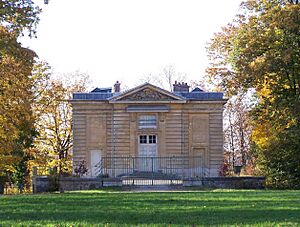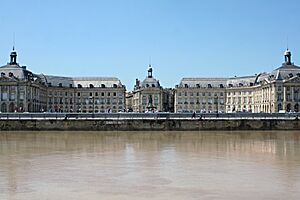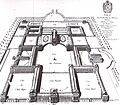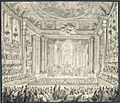Ange-Jacques Gabriel facts for kids
Quick facts for kids
Ange-Jacques Gabriel
|
|
|---|---|
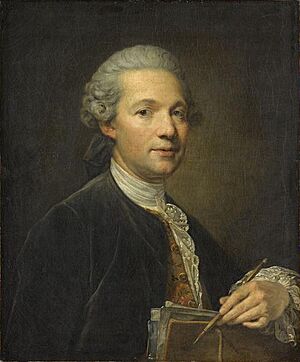
Ange Jacques Gabriel by Jean-Baptiste Greuze
|
|
| Born | 23 October 1698 |
| Died | January 4, 1782 (aged 83) Paris, Kingdom of France
|
| Occupation | Architect |
| Parent(s) | Jacques Gabriel |
Ange-Jacques Gabriel (born October 23, 1698 – died January 4, 1782) was a very important architect for King Louis XV of France. He designed famous buildings like the Place de la Concorde, the École Militaire, and the Petit Trianon and opera house at the Palace of Versailles. His style mixed older French Baroque ideas with newer Neoclassical ones.
Contents
Biography
Early Life and Becoming a Royal Architect
Ange-Jacques Gabriel was born in Paris into a well-known family of architects. His grandfather and father, Jacques Gabriel, were also famous builders. His father became the King's Controller of Buildings at a young age. Jacques Gabriel worked on big projects like the Rennes City Hall and the Place Royale in Bordeaux.
Ange-Jacques joined the Royal Academy of Architecture in 1728. He helped his father with the Place de la Bourse. In 1735, he became his father's main assistant at the Palace of Versailles. When his father passed away, Ange-Jacques took over as the King's chief architect. He worked under two directors of the King's Buildings, including the brother of Madame de Pompadour, who was the King's mistress and a big supporter of the arts.
Designing the Place de la Concorde
The Place Louis XV, now called the Place de la Concorde, was Gabriel's first major project. It was planned in 1748 and finished in 1772. The King wanted a grand square on some marshy land in Paris. Gabriel's design kept the views open towards the Seine river and the Champs-Élysées.
On the north side of the square, he built two matching palaces. He left a space between them to create a new street, the Rue Royale. This street connected the square to the Madeleine church. The front of these palaces looked like the famous Louvre museum, with rows of tall columns. A statue of Louis XV was placed in the center of the square. This statue was later removed during the French Revolution. Other statues and fountains were added in the 1800s.
Building the École Militaire
In 1751, King Louis XV decided to create the École Militaire. This was the first military academy in France. It was meant to train young men from noble families to become good soldiers. The school was built on the left bank of the Seine river in Paris.
Gabriel's design for the school looked like a grand "château" (a large country house). It had two wings and a central building with a dome, similar to the Louvre. The front of the building had strong Doric columns. Inside, there was a beautiful chapel and a grand hall called the Salle des Marechals. This hall was connected to the ground floor by a majestic ramp.
The Petit Trianon at Versailles
Madame de Pompadour asked Gabriel to design a smaller building at Versailles. She wanted a quiet place away from the main palace and the Grand Trianon. After a costly war ended, King Louis XV approved the plans. The Petit Trianon was built between 1763 and 1768.
The building was shaped like a cube, and each side looked different. They were decorated with columns and pediments that were perfectly balanced. The design of the Petit Trianon showed the pure form of the new Neoclassical style.
The Royal Opera of Versailles
Gabriel spent a lot of time making changes to the Palace of Versailles for King Louis XV. The palace needed a proper opera theater. A theater had been planned much earlier, but it was too expensive and complicated to build. Gabriel made a new plan in 1748, but it was also put on hold. He then worked on other parts of the palace, like finishing and extending the North Wing.
The Opera project was started again in 1765. It was rushed to be ready for the wedding of the future Louis XVI and Marie Antoinette in 1770. To finish quickly and save money, the theater was built mostly of wood. It was painted to look like marble, which also made the sound inside amazing. The theater was decorated in blue and gold. It was shaped like an oval and had many levels of boxes. Three thousand candles lit up the space, and their light reflected in mirrors.
The King's special box was larger than others and had a screen for privacy. Sculptures by Augustin Pajou and a painted ceiling by Louis Jean-Jacques Durameau completed the beautiful interior. Gabriel also thought about adding a way to raise the theater floor to stage level, to create a huge ballroom, but this was never finished.
Later Life and Death
His last projects included finishing the buildings he designed for the Place de la Concorde. These were the former Hôtel de Coislin and the Hotel Crillon, finished in 1770. He also built what is now the Hôtel de la Marine, which was the headquarters of the French Navy until 2016. This building was finished in 1774.
Ange-Jacques Gabriel passed away in Paris in 1782.
Style
Gabriel's style was very logical and careful in its design. He helped change architecture from the fancy Rococo style to the more simple and grand Neoclassical style. He wasn't known for being super bold or original. Instead, he often used ideas from older French classical buildings, like the Louvre.
He was known for his excellent craftsmanship and his ability to balance the lively Baroque style with the calmer Neoclassicism. His buildings had perfect proportions and careful details. He was also great at creating impressive and balanced groups of large buildings, like he did with the Place de la Concorde.
Major works
- Place de la Bourse, Bordeaux (originally Place Royale), 1730–1775, started by his father and finished by Gabriel after 1740.
- Changes and additions at the Château de Choisy, 1740–1777.
- Château de Compiègne, from 1750 onwards.
- Pavillon du Butard, 1750 at La Celle-Saint-Cloud.
- Additions to the Château de Menars (Loir-et-Cher), 1760–1764, for Madame de Pompadour.
- Petit Trianon, at Versailles, 1762 to 1768.
- École Militaire on the Champ de Mars, Paris.
- Royal Opera at the Palace of Versailles, 1769–70.
- Place de la Concorde (originally Place Louis XV), 1772.
- Hôtel de la Marine, Place de la Concorde, 1775.
- Hôtel de Crillon, Place de la Concorde.
See also
 In Spanish: Ange-Jacques Gabriel para niños
In Spanish: Ange-Jacques Gabriel para niños
- Neoclassicism in France
- Louis XV style
Images for kids
-
The École Militaire at dusk


